Netty Review - 优化Netty通信:如何应对粘包和拆包挑战_自定义长度分包编解码码器
发布时间:2023年12月23日

概述
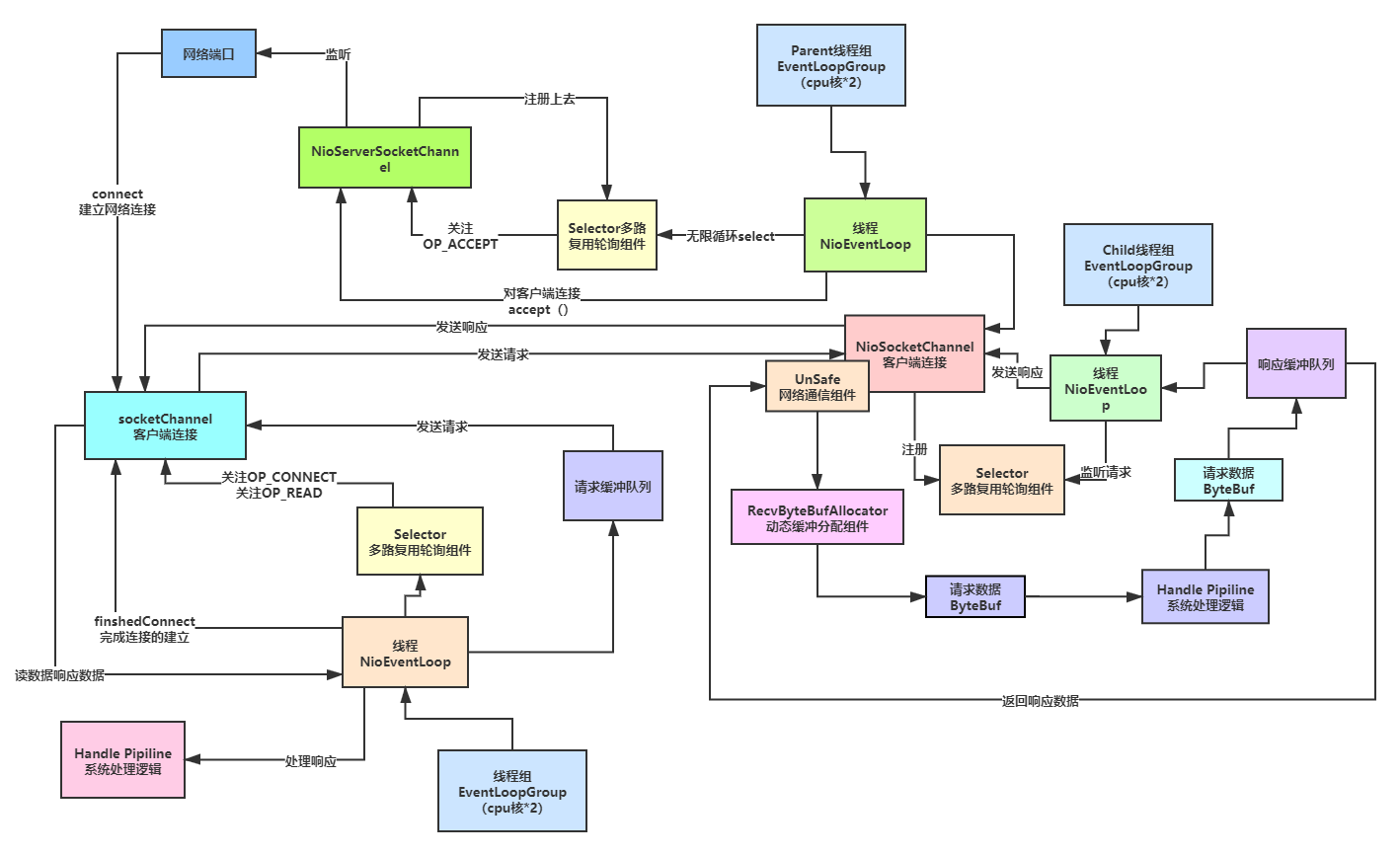
Pre
Netty Review - 借助SimpleTalkRoom初体验异步网络编程的魅力
Netty Review - 优化Netty通信:如何应对粘包和拆包挑战 中我们遗留了一个内容
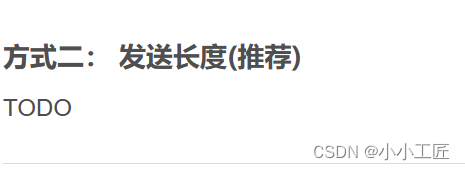
今天我们就通过自定义长度分包解码器来解决粘包拆包的问题
概述
在Netty中,自定义长度分包编解码器通常涉及到两个组件:
- 一个用于编码的
MessageToByteEncoder, - 另一个用于解码的
ByteToMessageDecoder。
Code
核心思路:发送每条数据的时候,将数据的长度一并发送,比如可以选择每条数据的前4位是数据的长度,应用层处理时可以根据长度来判断每条数据的开始和结束。

服务器端程序如下,其目的是创建一个服务,该服务器监听1234端口,并使用自定义的编解码器处理接收到的消息。
package com.artisan.pack_custom_codec;
import com.artisan.pack_custom_codec.codec.CustomMessageDecoder;
import io.netty.bootstrap.ServerBootstrap;
import io.netty.channel.*;
import io.netty.channel.nio.NioEventLoopGroup;
import io.netty.channel.socket.SocketChannel;
import io.netty.channel.socket.nio.NioServerSocketChannel;
/**
* @author 小工匠
* @version 1.0
* @mark: show me the code , change the world
*/
public class ArtisanServer {
public static void main(String[] args) throws InterruptedException {
// 主事件循环组,用于接受进来的连接,这里只设置了1个线程
EventLoopGroup bossGroup = new NioEventLoopGroup(1);
// 从事件循环组,用于处理已接受连接的IO操作,这里设置了8个线程
EventLoopGroup workerGroup = new NioEventLoopGroup(8);
try {
// 创建服务器启动类
ServerBootstrap bootstrap = new ServerBootstrap();
// 配置事件循环组
bootstrap.group(bossGroup, workerGroup)
// 使用NioServerSocketChannel作为服务器通道
.channel(NioServerSocketChannel.class)
// 设置一个选项,用于配置服务器同步接受连接的backlog大小
.option(ChannelOption.SO_BACKLOG, 1024)
// 配置子通道初始化处理器
.childHandler(new ChannelInitializer<SocketChannel>() {
@Override
protected void initChannel(SocketChannel ch) throws Exception {
// 获取通道的管道
ChannelPipeline pipeline = ch.pipeline();
// 添加自定义的解码器
pipeline.addLast("customDecoder",new CustomMessageDecoder());
// 添加业务处理handler
pipeline.addLast(new ArtisanServerHandler());
}
});
// 绑定端口并同步等待成功,打印成功启动信息
ChannelFuture channelFuture = bootstrap.bind(1234).sync();
System.out.println("Talk Room Server启动成功,监听1234端口");
// 关闭通道
// 这里的关闭是等待服务器socket关闭,通常在服务器关闭时调用
channelFuture.channel().closeFuture().sync();
} finally {
// 优雅地关闭主从事件循环组,释放资源
bossGroup.shutdownGracefully();
workerGroup.shutdownGracefully();
}
}
}
代码中主要涉及以下部分:
- 服务器端的启动类
ArtisanServer。 NioEventLoopGroup的使用,用于接受和处理网络事件。ServerBootstrap的配置,用于设置服务器参数。CustomMessageDecoder的使用,用于自定义消息的编解码方式。ArtisanServerHandler的添加,用于处理具体的业务逻辑。- 端口绑定和通道关闭的操作。
自定义协议
package com.artisan.pack_custom_codec.protocol;
/**
* @author 小工匠
* @version 1.0
* @mark: show me the code , change the world
* @description: 自定义协议
*/
public class CustomMessageProtocol {
/**
* 定义一次发送包体长度
*/
private int len;
/**
* 一次发送包体内容
*/
private byte[] content;
public int getLen() {
return len;
}
public void setLen(int len) {
this.len = len;
}
public byte[] getContent() {
return content;
}
public void setContent(byte[] content) {
this.content = content;
}
}
自定义解码器
server端接收网卡过来的消息,入站事件,自然是要解码,将网络传输的二进制数据转换为对象
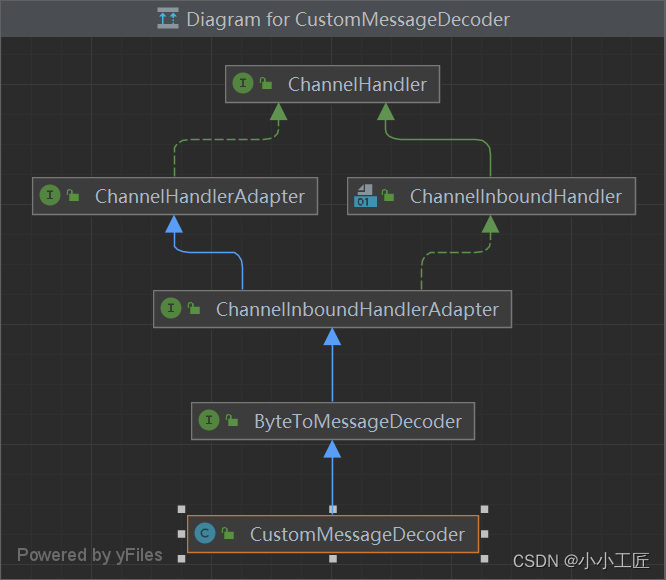
package com.artisan.pack_custom_codec.codec;
import com.artisan.pack_custom_codec.protocol.CustomMessageProtocol;
import io.netty.buffer.ByteBuf;
import io.netty.channel.ChannelHandlerContext;
import io.netty.handler.codec.ByteToMessageDecoder;
import java.util.List;
/**
* @author 小工匠
* @version 1.0
* @mark: show me the code , change the world
*/
public class CustomMessageDecoder extends ByteToMessageDecoder {
int length = 0;
@Override
protected void decode(ChannelHandlerContext ctx, ByteBuf in, List<Object> out) throws Exception {
System.out.println();
System.out.println("CustomMessageDecoder decode 被调用");
//需要将得到二进制字节码-> CustomMessageDecoder 数据包(对象)
System.out.println(in);
// int 占 4个字节 (int 类型占用4个字节,即32位)
if (in.readableBytes() >= 4) {
if (length == 0) {
length = in.readInt();
}
if (in.readableBytes() < length) {
System.out.println("当前可读数据不够,继续等待。。");
return;
}
byte[] content = new byte[length];
if (in.readableBytes() >= length) {
in.readBytes(content);
//封装成CustomMessageDecoder对象,传递到下一个handler业务处理
CustomMessageProtocol messageProtocol = new CustomMessageProtocol();
messageProtocol.setLen(length);
messageProtocol.setContent(content);
out.add(messageProtocol);
}
length = 0;
}
}
}
服务端的消息处理
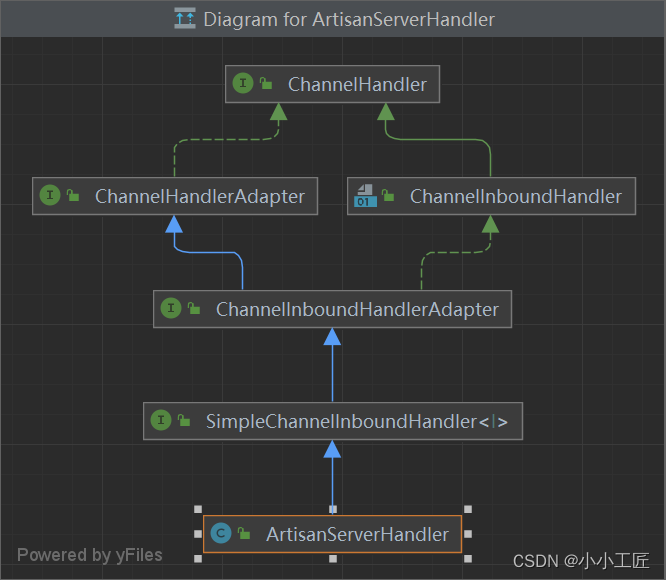
package com.artisan.pack_custom_codec;
import com.artisan.pack_custom_codec.protocol.CustomMessageProtocol;
import io.netty.channel.ChannelHandlerContext;
import io.netty.channel.SimpleChannelInboundHandler;
import io.netty.util.CharsetUtil;
/**
* @author 小工匠
* @version 1.0
* @mark: show me the code , change the world
*/
public class ArtisanServerHandler extends SimpleChannelInboundHandler<CustomMessageProtocol> {
private int count;
@Override
protected void channelRead0(ChannelHandlerContext ctx, CustomMessageProtocol msg) throws Exception {
System.out.println("====服务端接收到消息如下====");
System.out.println("长度=" + msg.getLen());
System.out.println("内容=" + new String(msg.getContent(), CharsetUtil.UTF_8));
System.out.println("服务端接收到消息包数量=" + (++this.count));
}
@Override
public void exceptionCaught(ChannelHandlerContext ctx, Throwable cause) throws Exception {
cause.printStackTrace();
ctx.close();
}
}
接下来继续看看客户端该如何处理 ?
客户端启动类
package com.artisan.pack_custom_codec;
import com.artisan.pack_custom_codec.codec.CustomMessageEncoder;
import io.netty.bootstrap.Bootstrap;
import io.netty.channel.*;
import io.netty.channel.nio.NioEventLoopGroup;
import io.netty.channel.socket.SocketChannel;
import io.netty.channel.socket.nio.NioSocketChannel;
import java.util.Scanner;
/**
* @author 小工匠
* @version 1.0
* @mark: show me the code , change the world
*/
public class ArtisanClient {
public static void main(String[] args) throws InterruptedException {
EventLoopGroup group = new NioEventLoopGroup();
try {
Bootstrap bootstrap = new Bootstrap();
bootstrap.group(group)
.channel(NioSocketChannel.class)
.handler(new ChannelInitializer<SocketChannel>() {
@Override
protected void initChannel(SocketChannel ch) throws Exception {
ChannelPipeline pipeline = ch.pipeline();
// 自定义长度分包编码器
pipeline.addLast("customEncoder",new CustomMessageEncoder());
//加入自己的业务处理handler
pipeline.addLast(new ArtisanClientHandler());
}
});
ChannelFuture channelFuture = bootstrap.connect("127.0.0.1", 1234).sync();
//得到 channel
Channel channel = channelFuture.channel();
System.out.println("========" + channel.localAddress() + "========");
//客户端需要输入信息, 创建一个扫描器
Scanner scanner = new Scanner(System.in);
while (scanner.hasNextLine()) {
String msg = scanner.nextLine();
//通过 channel 发送到服务器端
channel.writeAndFlush(msg);
}
// 阻塞操作,closeFuture()开启了一个channel的监听器(这期间channel在进行各项工作),直到链路断开
channelFuture.channel().closeFuture().sync();
} finally {
group.shutdownGracefully();
}
}
}
这段代码定义了一个名为CustomMessageEncoder的Netty编解码器,用于将自定义协议的消息编码为字节流。下面是代码的详细解释:
CustomMessageEncoder类继承自MessageToByteEncoder<CustomMessageProtocol>,这意味着它将被用于编码CustomMessageProtocol类型的消息。encode方法在需要将消息编码为字节流时调用。在这个方法中,首先打印了一条消息,表明encode方法被调用了。然后,它将消息的长度写入到输出缓冲区out中,接着将消息内容写入到输出缓冲区。
这个编解码器的主要作用是将自定义协议的消息转换为字节流,以便可以在网络上传输。它首先写入消息的长度,然后写入消息的内容,这样接收方就可以根据长度来解析消息的内容。
自定义编码器
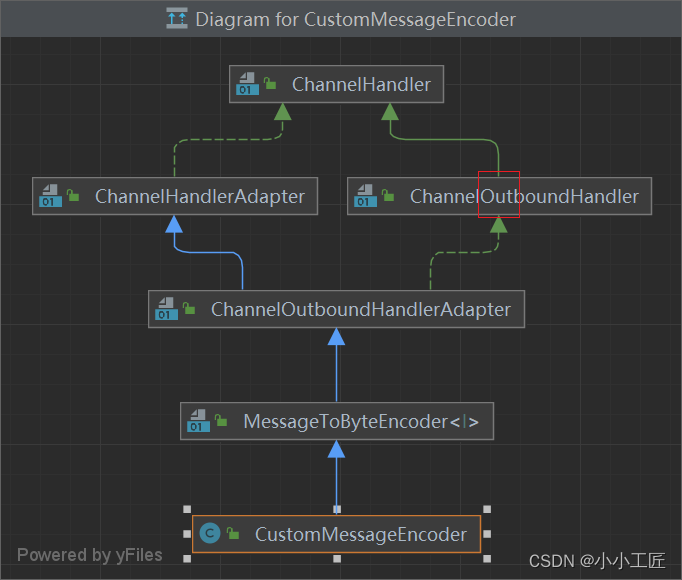
package com.artisan.pack_custom_codec.codec;
import com.artisan.pack_custom_codec.protocol.CustomMessageProtocol;
import io.netty.buffer.ByteBuf;
import io.netty.channel.ChannelHandlerContext;
import io.netty.handler.codec.MessageToByteEncoder;
/**
* @author 小工匠
* @version 1.0
* @mark: show me the code , change the world
*/
public class CustomMessageEncoder extends MessageToByteEncoder<CustomMessageProtocol> {
@Override
protected void encode(ChannelHandlerContext ctx, CustomMessageProtocol msg, ByteBuf out) throws Exception {
System.out.println("CustomMessageEncoder encode called~");
out.writeInt(msg.getLen());
out.writeBytes(msg.getContent());
}
}
客户端发数据到网卡,出站事件 , 需要编码。
客户端业务处理Handler
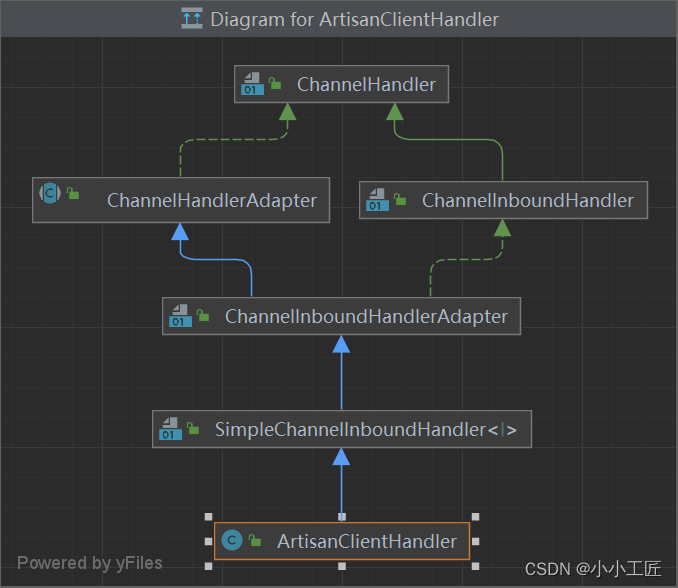
package com.artisan.pack_custom_codec;
import com.artisan.pack_custom_codec.protocol.CustomMessageProtocol;
import io.netty.channel.ChannelHandlerContext;
import io.netty.channel.SimpleChannelInboundHandler;
import io.netty.util.CharsetUtil;
/**
* @author 小工匠
* @version 1.0
* @mark: show me the code , change the world
*/
public class ArtisanClientHandler extends SimpleChannelInboundHandler<CustomMessageProtocol> {
@Override
public void channelActive(ChannelHandlerContext ctx) throws Exception {
for (int i = 0; i < 2; i++) {
String msg = "小工匠的Netty Review之旅";
//创建协议包对象
CustomMessageProtocol customMessageProtocol = new CustomMessageProtocol();
customMessageProtocol.setLen(msg.getBytes(CharsetUtil.UTF_8).length);
customMessageProtocol.setContent(msg.getBytes(CharsetUtil.UTF_8));
ctx.writeAndFlush(customMessageProtocol);
}
}
@Override
protected void channelRead0(ChannelHandlerContext ctx, CustomMessageProtocol msg) throws Exception {
}
@Override
public void exceptionCaught(ChannelHandlerContext ctx, Throwable cause) throws Exception {
cause.printStackTrace();
ctx.close();
}
}
这段代码定义了一个名为ArtisanClientHandler的Netty处理器,用于处理自定义协议的消息。下面是代码的详细解释:
ArtisanClientHandler类继承自SimpleChannelInboundHandler<CustomMessageProtocol>,这意味着它将被用于处理CustomMessageProtocol类型的消息。channelActive方法在Netty通道激活时调用。在这个方法中,代码循环两次,发送一个包含特定字符串的消息。每次循环,它都会创建一个CustomMessageProtocol对象,设置消息长度,并填充内容,然后通过ctx.writeAndFlush方法将消息写入通道。channelRead0方法在接收到消息时调用。在这个例子中,该方法为空,没有实现任何功能。exceptionCaught方法在捕获到异常时调用。在这个方法中,它打印了异常的堆栈跟踪,并关闭了通道。
测试
启动server 和 client
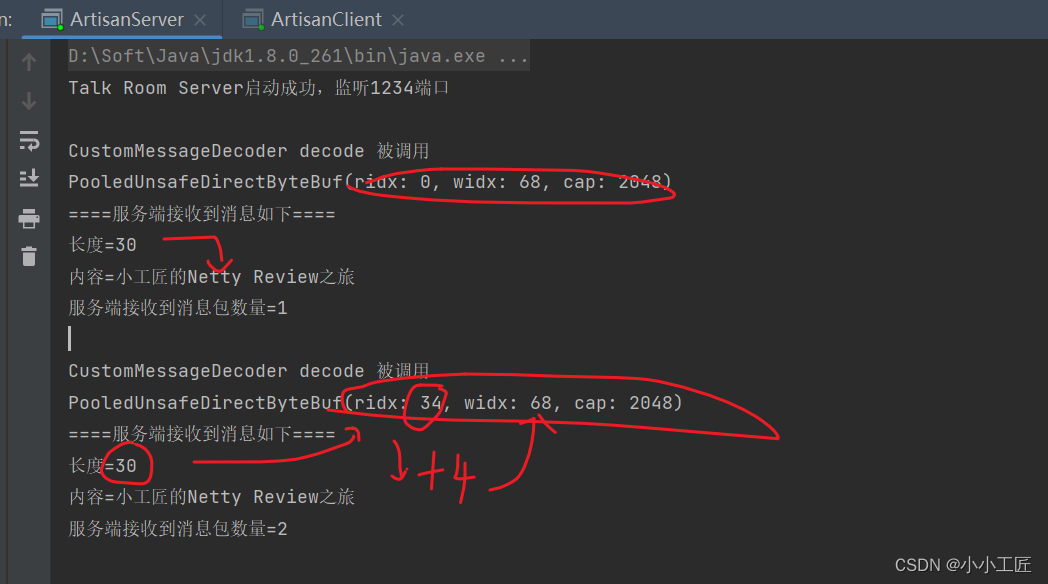
文章来源:https://blog.csdn.net/yangshangwei/article/details/135169205
本文来自互联网用户投稿,该文观点仅代表作者本人,不代表本站立场。本站仅提供信息存储空间服务,不拥有所有权,不承担相关法律责任。 如若内容造成侵权/违法违规/事实不符,请联系我的编程经验分享网邮箱:chenni525@qq.com进行投诉反馈,一经查实,立即删除!
本文来自互联网用户投稿,该文观点仅代表作者本人,不代表本站立场。本站仅提供信息存储空间服务,不拥有所有权,不承担相关法律责任。 如若内容造成侵权/违法违规/事实不符,请联系我的编程经验分享网邮箱:chenni525@qq.com进行投诉反馈,一经查实,立即删除!
最新文章
- Python教程
- 深入理解 MySQL 中的 HAVING 关键字和聚合函数
- Qt之QChar编码(1)
- MyBatis入门基础篇
- 用Python脚本实现FFmpeg批量转换
- 第四站:指针的进阶-(二级指针,函数指针)
- HarmonyOS:使用MindSpore Lite引擎进行模型推理
- 基于SSM框架的餐馆点餐系统的设计论文
- 《Spring Cloud学习笔记:Nacos配置管理 & OpenFeign & Getway》
- Centos7在安装Graylog时新安装MongoDB报错端口不监听服务不启动无法运行启动失败
- YOLOv8改进 | Conv篇 | 2024.1月最新成果可变形卷积DCNv4(全网独家首发,附详细教程)
- 15.云原生之k8s容灾与恢复实战
- 2023 北京国炬软件年度总结—JeecgBoot与敲敲云
- 身为程序员,这几款工具老少皆宜
- Element Ui 表格自定义滚动条,以及自定义滚动条后出现空白问题